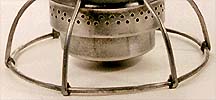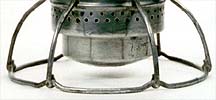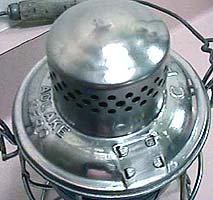|
|
Adams & Westlake "Kero" Lanterns:
The Last Stand
by Ted Douthitt Jr. and Jerry Gorzoch
The Adams & Westlake #300/400 Kero is one of the more common railroad
lanterns in today's collectors' market. This is the last kerosene railroad
lantern manufactured by Adams & Westlake and is still in production,
although not for regular railroad use. While the same basic model designation
has been in effect for well over 60 years, there have been a number of
design changes that distinguish Kero's of different era's. Based on examining
more examples than we ever intended, here are five versions that we've
identified:
Version 1. This one is easy since we are talking about the original
version as found in Adlake Bulletin B-84-A made in the Elkhart Factory.
We will not describe every subtle variation since there were at least
four different bails  alone.
The main feature of the A&W Kero made from 1930 to about 1935 is
that the lantern has a completely flat wire bottom, unlike all of the
later Kero's. The bottom ring is the same as the one in the Adlake #200
and #250. See photo at left from a 1934 Kero. We should note that the
current "post-railroad use" version of the Kero with "fantasy" or
commemorative markings (see below) has once again appeared with a flat
wire bottom. These Kero's are undated however, so Version 1 lanterns
are distinguished by a flat wire bottom and a date from the early 1930's. alone.
The main feature of the A&W Kero made from 1930 to about 1935 is
that the lantern has a completely flat wire bottom, unlike all of the
later Kero's. The bottom ring is the same as the one in the Adlake #200
and #250. See photo at left from a 1934 Kero. We should note that the
current "post-railroad use" version of the Kero with "fantasy" or
commemorative markings (see below) has once again appeared with a flat
wire bottom. These Kero's are undated however, so Version 1 lanterns
are distinguished by a flat wire bottom and a date from the early 1930's.
Version
2. The first major change in the Model 300/400 came in about 1935 or  1936.
Here, the wire bottom is no longer completely flat but rises up to
meet the vertical wire guards. This was the only major change for roughly
a decade, but all Kero's up to the present have retained this feature.
See photo at right from a 1938 Kero. 1936.
Here, the wire bottom is no longer completely flat but rises up to
meet the vertical wire guards. This was the only major change for roughly
a decade, but all Kero's up to the present have retained this feature.
See photo at right from a 1938 Kero.
Version 3. In late 1945, it appears
that some "Armspear
type" parts
were more or less merged into the Kero. Specifically the lid latch (the one
with a strip of steel and two rivets) became the "standard", replacing the
bent wire spring. This had been a feature of most Armspear lanterns since the
first "Model 1925" lantern. At the same time the dome was changed
so that "ADLAKE KERO" was stamped into the top of the dome. Previous
Kero's (Versions 1 & 2 ) were marked Adams & Westlake Co. on the skirt front
of the lid. This style remained until about 1964 when the month and year lettering
stamped under the pot holder was eliminated. Updates - See new updates on Versions 3 and 4 at the bottom of the page.]
Version 4. In about 1965/66 there
were several changes. One was that the wording on the bottom of the font
holder was changed to: Adlake Kero.. USA Canada..PATENDED. A second was
that a drain hole was added to the very bottom of the font holder. Yes,
Virginia, those holes were factory made and not done by a bunch of antique
dealers trying to make lamps out of old railroad lanterns. A third change
was that the lid, which previously had two soldered-on nail-like devices
to keep the globe retainer in place, was redesigned so that the lid had
two stamped impressions in the sides to hold the globe retainer. By the
way, the globe retainer itself was -- and still is -- the same design
as the original. It is still being made. [Updates - See new updates on Versions 3 and 4 at the bottom of the page.]
Version 5. About 1970 or so, the tooling at Adams & Westlake broke.
New tooling was made, but the Kero design was changed such that the smoke
dome was, for
lack of a better description... bald (See photo at right, by Paul Hoste).
There was no writing on the top and no ridges between the vent holes
on the lid. On the skirt of the dome on either side were marked the railroad
name and the words "ADLAKE KERO." The bottom of the font holder
was bald as well. At a point later on, the word "ADLAKE KERO" were
eliminated, although there are reports of some lanterns having only the
word "Railroad " stamped on the skirt of the dome. for
lack of a better description... bald (See photo at right, by Paul Hoste).
There was no writing on the top and no ridges between the vent holes
on the lid. On the skirt of the dome on either side were marked the railroad
name and the words "ADLAKE KERO." The bottom of the font holder
was bald as well. At a point later on, the word "ADLAKE KERO" were
eliminated, although there are reports of some lanterns having only the
word "Railroad " stamped on the skirt of the dome.
What were the last railroads to order marked Kero's? We have been able
to verify a number of "late models" which we feel are from
the very late 1960's through the 1970's. Adams & Westlake continues
to sell the Adlake Kero 300/400 for specialty purposes, but we are referring
here to the last railroad lanterns bought by real North American railroads
for use in service, in other words, the "Last Stand":
- B.N. Inc. (Burlington Northern)
- B&O. RR (Baltimore and Ohio RR)
- C&O (Probably just before
the merger)
- C. P. R. (Canadian Pacific Railway)
- C. N. R. (Canadian National Railways)
- C.T.A. (Chicago Transit Authority)
- DM&IR RR (Duluth, Missabe & Iron
Range - use of "RR" is
a first)
- I.C. R.R. (Illinois Railroad)
- PC (Penn Central)
- Sou Ry (Southern Railway)
- W.T. Co. (Washington Terminal)
- WMATA (Washington Area Metropolitan
Transit Authority)
- The Washington Terminal Co. was reportedly still
buying Kero's as late as 1975. We also have good information that late
model Southern Railway lanterns were made but only marked with a number "927".
The origin of this number remains a mystery, at least to us. Finally,
at least two modern transit authorities - Chicago Transit Authority
and Washington Area Metropolitan Transit Authority -- apparantly used
Kero's into the late 1970's. For the time-being, we will use 1979 as
the cutoff date for the regular use of Kero's in railroad service.
A Postscript: No history of the Kero would be complete without
at least mentioning its fate in "retirement " from real
railroad service. The Kero has enjoyed a new lease on life as a "fantasy" lantern,
doing cameo appearances for railroad clubs, museums, and other
organizations! Numerous organizations have ordered Kero's from
the Adams & Westlake Company with "railroad-like" markings
for promotional, commemorative, or fund-raising purposes. Actually,
a real railroad, Norfolk Southern, bought marked Kero's in 1998,
but these were purchased as promotional items, not for regular
railroad use.
Since the latest Kero's are "modern style" models, often
of a lighter weight than their older counterparts, these lanterns
should fool no one....but they sometimes do. There are reports
of such lanterns going for fairly high auction prices, most likely
purchased unknowingly by new collectors. A particularly good example
is a Kero marked "G.C. & S.J. R.R. for "Golden City & San
Juan Railroad." The marking sounds like a grand old Colorado
narrow gauge line, but in reality it is an modern invention of
the Colorado Railroad Museum which sold such lanterns in its giftshop.
We cover these new lanterns in a separate article "A&W
Kero's: Heritage Lanterns". For now it is safe to say
that the Kero, in all of its forms, is alive and well and will
continue to be a focus of collectors for a long time to come.
Updates:
We received the following comment in early 2015: "Regarding your article on "Adams & Westlake "Kero" Lanterns: The Last Stand" I have a lamp the may shed additional information. The article states for Version 3 that ADLAKE KERO" was stamped into the top of the dome (in addition to other information) and that the style remained until about 1964 when the month and year lettering stamped under the pot holder was eliminated. My lamp is stamped with the date 3-64 (March 1964). However, the article states in Version 4 that the wording on the bottom of the font holder was changed to: Adlake Kero.. USA Canada..PATENDED, a drain hole was added to the bottom, and the lid was redesigned with two stamped impressions in the sides to hold the globe retainer. My lamp has all these features yet has the date stamp from Version 3. Also, the very top of the lid which has the ADLAKE KERO stamped on it also has the symbol for the Pennsylvania Railroad (keystone with overlapping PRR) centered at the top." [Our thanks to PB for the comment.]
We received another comment in mid-2016: "I recently acquired a "KERO" short globe lamp from my stepfather. It had belonged to his father who had worked for the C&O Railroad in the Kentucky/Ohio region in the mid 1930's to the early 1950's. those dates can be confirmed. This lamp has a date (I assume) stamped on the bottom of 1 51. It has all the features listed for Version 3 EXCEPT like the Version 4 (1965 and later models) it has the "Adlake Kero.. USA Canada..PATENDED" stamped on the bottom and the date 1 51 as well. In addition, it does NOT have the "drain hole" on the bottom, and it still has the "two soldered-on nail-like devices to keep the globe retainer in place". All parts look original and the lamp is well used but still intact. So if the date is correct, which seems to be the case, then some adjustment to the versions may be in order? [Our thanks to HH for the comment.]
Acknowledgments: Thanks to everyone who contributed
information. |